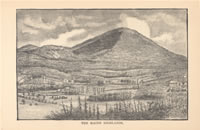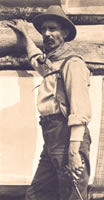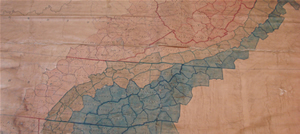A Region Defined:
The Southern Highlands
The mountainous Appalachian region entered into the mainstream of American consciousness in the late 19th century, after rail travel made inroads into previously inaccessible places. By the 1870s travel books with highly detailed illustrations brought images of remote mountains to American population centers in the East.
The idea that Appalachia was more than a geographic entity began to gain credence in the last decade of the 19th century. In Kentucky, William Goodell Frost (1854-1938), president of Berea College, was one of the first to write about Appalachia as a region with an identifiable culture. Using the term Appalachian America in his frequent fundraising speeches, Frost defined the new geographic entity as “a new grand division…a mountainous back yard…extending from the line of Pennsylvania to the iron hills of Birmingham.” Curiously, Frost’s geography coincides closely with the official definition of Appalachia used by the US Appalachian Regional Commission today.
The realization that the 20th century would bring change to rural communities and community life focused national attention on country life. Former St. Louis librarian, Horace Kephart (1862-1931), came to the Smoky Mountains in 1904 and chronicled his travels in articles and photographs. In 1913, Kephart published Our Southern Highlanders, a book that defined and introduced mountain culture to the American public. Kephart is credited with popularizing the notion that the Great Smoky Mountains should be preserved as a public park.
As a region, Appalachia both mirrors the diversity of American culture and stands apart from it as a distinctive place. It is a region historically defined by stereotype, misconception, and mythology. Popularized in dime store novels, the mountains provided an exotic backdrop for romantic novels and adventure stories. Too often authors sensationalized the region and peopled it with ignorance, poverty, and violence. Industrial speculators also branded mountain citizens with negative stereotypes. Such labels were used to justify unfair and unsafe labor practices that polluted water and scarred the countryside in the extraction of the region’s wealth of timber and coal.
During the first decade of the new century, Olive Dame and John C. Campbell traveled throughout the Southern mountains, she studying folk traditions while he collected official data for an early demographic study of the region. In 1917, Olive Dame Campbell co-authored English Folk-Songs from the Southern Appalachians with English ballad collector Cecil J. Sharp. In a letter to her fellow ballad collaborator, Campbell defined the folk movement (as she called it) as that which seeks the “preservation of all that is native and fine.” John’s study, compiled by Olive and published posthumously in 1921, is the seminal text The Southern Highlander and his Homeland. Both Campbells attempted to document and preserve the culture of western North Carolina and the surrounding mountain region.






